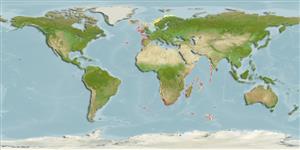Lớp phụ Cá sụn (cá mập và cá đuối) (sharks and rays) >
Squaliformes (Sleeper and dogfish sharks) >
Squalidae (Dogfish sharks)
Etymology: Squalus: Genus name from Latin 'squalus' meaning shark (Ref. 6885, 27436); margaretsmithae: Named for Professor Margaret Mary Smith, first director of the former J.L.B. Smith Institute (currently
SAIAB).
Eponymy: Professor Margaret Mary Smith née Macdonald (1916–1987) was a South African ichthyologist. [...] (Ref. 128868), visit book page.
Issue
Species information for completion.
Environment: milieu / climate zone / Mức độ sâu / distribution range
Sinh thái học
Biển pelagic-neritic; Mức độ sâu 256 - 284 m (Ref. 116247). Tropical
Eastern Atlantic Ocean from Portugal and Morocco to South Africa.
Bộ gần gũi / Khối lượng (Trọng lượng) / Age
Chín muồi sinh dục: Lm ? range ? - ? cm
Max length : 54.3 cm TL con đực/không giới tính; (Ref. 116247)
Short description
Khóa để định loại | Hình thái học | Sinh trắc học
Động vật có xương sống: 107 - 115. This species is distinguished from its regional congeners (except S. acutipinnis) by having broad pectoral fins that transcend trunk height when adpressed on body, with length of pectoral fin anterior margin 16.5%, 15.9-17.9% TL; differs from S. chloroculus, S. edmundsi, S. lalannei, S. mitsukurii, S. montalbani, S. nasutus by having a smaller snout with prenarial length shorter than distance from nostril to upper labial furrow, and unicuspid and lanceolate dermal denticles (vs. prenarial length greater than distance from nostril to upper labial furrow, and tricuspid and rhomboid dermal denticles); differs from S. megalops, S. brevirostris by having postventral caudal margins that are not uniformly white (vs. postventral caudal margins uniformly white in megalops, brevirostris). differs from S. mahia by having dermal denticles that are wide at the crown (vs. dermal denticles slender at crown in megalops, mahia); differs from S. brevirostris, S. crassispinus by having a shorter dorsal-caudal space, 11.2%, 10.8-12.2% TL (vs. 10.1-10.6% for brevirostris and 9.9-10.0% TL for crassispinus), and from S. mahia, S. crassispinus by the prespiracular length 11.5% TL, 11.7-12.3% TL (vs. 12.4%, 12.4-13.9% TL for mahia and 12.5-12.7% TL for crassispinus); further differs from S. crassispinus by its shorter preorbital length, 6.5%, 6.4-7.0% TL (vs. 7.3-7.4% TL), its larger pectoral fins with pectoral fin inner margin length 9.7%, 9.2-10.6% TL (vs. 8.6% TL), its pectoral fin posterior margin length 11.3%, 11.8-14.5% TL (vs. 9.0-9.4% TL), greater pre-first dorsal fin length, 28.2%, 28.1-32.2% TL (vs. 26.7-27.4% TL), its wider mouth, its widhe 7.6%, 7.8-9.0% TL (vs. 7.4% TL), and shorter pelvic-caudal distance, 25.1%, 24.9-27.2% TL (vs. 27.9-28.1% TL); differs from S. acutipinnis by having a first dorsal fin somewhat upright and rounded at apex, its posterior margin concave at its midline (vs. fin prone and pointed at apex, its posterior margin straight throughout in), caudal fork between lobes discontinuous (vs. continuous), dermal denticles with length greater than width and symmetrical lateral expansions (vs. dermal denticles somewhat equal in length and width, and asymmetrical lateral expansions), its upper teeth narrow, lower teeth depressed, cusp very short and somewhat oblique, straight mesial cutting edge, rounded mesial heel, and apron very short in both jaws (vs. upper teeth broad, lower teeth tall, cusp elongate and directed upward, concave mesial cutting edge, constricted mesial heel, and apron shorter only in upper teeth) (Ref. 116247).
Body shape (shape guide): elongated; Cross section: angular.
Life cycle and mating behavior
Chín muồi sinh dục | Sự tái sinh sản | Đẻ trứng | Các trứng | Sự sinh sản | Ấu trùng
Viana, S.T. d. F.L., M.W. Lisher and M.R. de Carvalho, 2017. Two new species of short-snouted dogfish sharks of the genus Squalus Linnaeus, 1758, from southern Africa (Chondrichthyes: Squaliformes: Squalidae). Mar. Biodiv. 1-28. (Ref. 116247)
IUCN Red List Status (Ref. 130435: Version 2025-1)
Threat to humans
Harmless
Human uses
Các nghề cá: có khả năng có lợi
Các công cụ
Special reports
Download XML
Các nguồn internet
Estimates based on models
Phylogenetic diversity index (Tài liệu tham khảo
82804): PD
50 = 0.5000 [Uniqueness, from 0.5 = low to 2.0 = high].
Bayesian length-weight: a=0.00347 (0.00165 - 0.00730), b=3.09 (2.92 - 3.26), in cm total length, based on LWR estimates for this Genus-body shape (Ref.
93245).
Mức dinh dưỡng (Tài liệu tham khảo
69278): 4.2 ±0.3 se; based on size and trophs of closest relatives
Thích nghi nhanh (Tài liệu tham khảo
120179): thấp, thời gian nhân đôi của chủng quần tối thiểu là 4.5 - 14 năm (Preliminary K or Fecundity.).
Fishing Vulnerability (Ref.
59153): Moderate vulnerability (42 of 100).
🛈
